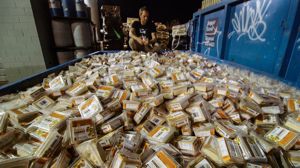As your camera pans dramatically over a patchwork of rural fields, I was reminded of the "Oh Canada" video clip TV stations used to play right before they signed off for the night. While our national anthem swelled in the background, the camera swept high over our home and native land: waves crashing in the Maritimes, an eagle soaring over the Rockies, and a triumphant vista of bountiful farmer's fields. Before turning off the TV and turning in for the night, this video was a reassuring reminder of how fortunate we are to live in a country of such abundance. But, as the documentary Just Eat It reveals, abundance has a dark side.
Director Grant Baldwin and his partner, producer Jennifer Rustemeyer, know first-hand that the world has a food waste problem. To prove just how out of control food waste has become, they spent six months living - and living well - only on food they 'rescued' from dumpsters. Perfectly good food that was discarded because retailers only want to provide the best-looking, freshest product. What most consumers don't realize is the serious impact this waste has on our environment. In their film, Grant and Jennifer set out to expose the dirty secret the food industry doesn't want us to know: that approximately one third of all food produced worldwide is not eaten.
Atop your aerial perch you probably couldn't quite make out the swimming pool-sized dumpster filled with unexpired containers of hummus, the slightly blemished yet still succulent peaches bouncing off a conveyor belt into a bin marked 'rejected', the boxes of expensive organic chocolate bars, a year from expiring, that fill Grant's Subaru. From your bird's-eye view you might have seen the field of celery strewn with perfectly edible outer stalks--but you wouldn't have heard the farmer lament that he was standing in 2 pounds of waste per square foot that costs more in labour to save than it does to toss. The problem, we learn, is that supermarket standards for food are higher than those set by the government. In short, with our demand for the perfect apple and the freshest bread, we the consumers have brought this upon ourselves.
In one particularly clever time-lapse sequence, we see the life of a bell pepper from its early days growing large on the stalk, to the factory process as its picked, washed, and deemed worthy of human consumption. After being loaded onto a transport truck, you and your flying camera take over, showing us the truck rambling like a child's toy down a British Columbia highway towards its temporary home at a grocery store, where, finally, its purchased and left to rot in a refrigerator crisper. This little example of how we take food for granted was adorably set to the classic 80s pop ballad "(Don't You) Forget About Me." More sobering, however, were the accompanying facts: the amount of water required to maintain just the food we throw away could meet the needs of 500 million people. Tristram Stuart, author of the book Waste, puts it more bluntly: "We're trashing our land to grow food we don't eat."
Just curious; did you wear a mask the day you filmed that massive bulldozed landfill? We learn that 97% of U.S. food waste ends up here, mostly still in its packaging, which makes biodegradation next to impossible and contributes to the production of harmful greenhouse gasses. Sadly, most food banks lack the resources to recover this food.
But before you get depressed, the film also takes us to more progressive places, like the pig farm outside Las Vegas that feeds its livestock 1000 tons of food waste every month (I'm guessing after the landfill, you're pretty thankful the script didn't call for an aerial shoot there).
Just Eat It is more a call to action than a chastisement. After all, we're all guilty of throwing away food. What saves this film from being another gimmicky Super Size Me or _No Impact Man _is Grant and Jennifer's modestly charming Canadian-ness. They present some pretty frightening statistics, but they also offer some helpful solutions, from meal planning, to gleaning (volunteer outings to collect unharvested crops for food banks), to volunteering at grocery stores that 'rescue' the food supermarkets won't sell, providing it at bargain prices to those in need. You make a great team: from the sky, you're able to show us the sweeping agribusiness landscapes as far as the eye can see, while Grant and Jennifer are the boots on the ground, putting the food and food retail industries under the microscope.
Let's hope it's all enough to give us the big picture.
Try not to look down,
Di







